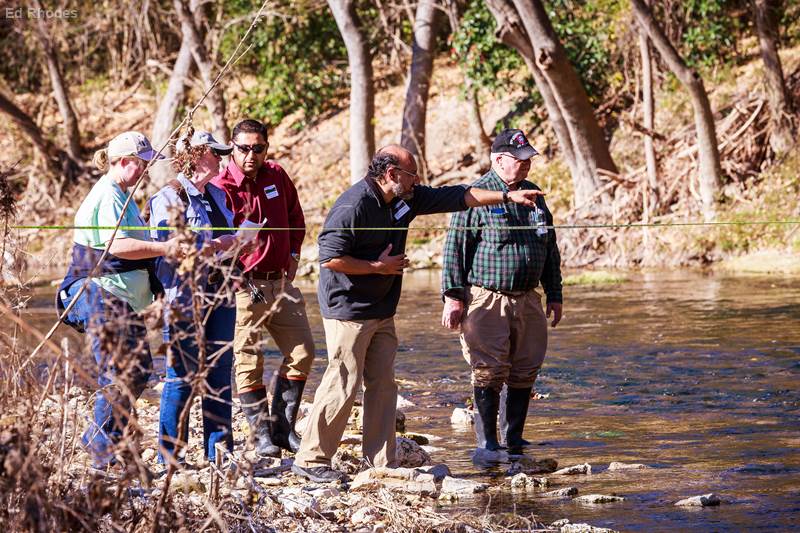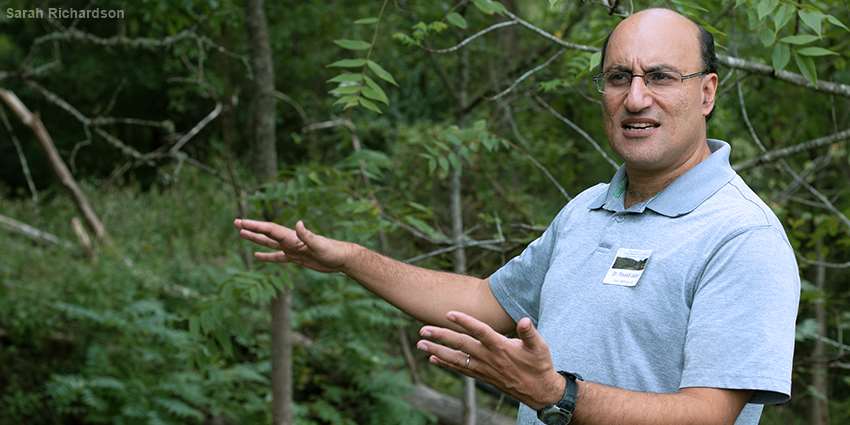Every day, Dr. Fouad Jaber asks and answers two questions about his work in integrated water resource management: What’s the problem, and what are we going to do about it?
As a Texas A&M University associate professor and extension specialist at the Texas A&M AgriLife Research and Extension Center at Dallas, Jaber is solution-oriented. He likes doing things — not just thinking about solutions but turning them into a reality. In his work, the solutions often involve green infrastructure and natural water channel restoration.
“I apply concepts of ecological engineering to managing urban water, which specifically means that I use natural elements to try to solve problems related to stormwater pollution,” Jaber said.
Jaber was born and raised in Beirut, Lebanon, which, he said, “is probably one of the biggest concrete jungles in the world.” Despite the lack of nature, he studied agriculture and irrigation for his bachelor’s and master’s degrees, respectively. After a year of hydrology consulting, he came to the United States to pursue a doctorate in agricultural and biological engineering at Purdue University. In 2007, after a postdoc at the University of Florida, he began working at the Dallas center.
At the center, Jaber works on runoff in urban environments. When land gets urbanized, pervious land — land that water can soak into — is changed to impervious land such as parking lots and sidewalks. Trees and other plants that once slowed down, reabsorbed and naturally treated water are removed.
Jaber gave the example of a big box store being built.
“Before the store was there, some rainwater infiltrated into the soil, and some ran off,” Jaber said. “When you build the store, you put in a huge parking lot, and now rain can’t infiltrate. It runs off and [goes] in a stormwater pipe network to rivers and streams, picking up every pollutant along the way.”
Jaber uses green infrastructure, such as rain gardens, to address issues such as this. Green infrastructure mimics natural processes, solving ecological issues at the source rather than downstream.
“A rain garden is basically a depression placed so that runoff, like from parking lots, goes into it. We remove some of the native soil, put a high-infiltration soil mix in and plant it. Runoff flows into the depression, filling up the soil first,” Jaber said. “Some of the water will go out, but a lot will infiltrate into the soil. As a result, the runoff is cleaner, and there’s much less of it.”
Green roofs, rainwater harvesting and permeable pavement are other common examples of green infrastructure that Jaber uses. All methods minimize runoff, thereby also reducing the pollutants that enter streams and rivers.
Excess runoff doesn’t just deliver pollutants to water bodies. To minimize flooding, impervious areas such as roads are sloped so that water flows away as fast as possible, delivering more water faster to streams and rivers and causing erosion.
“Rivers have a natural way to form. When it rains, runoff flows down slopes to the lowest point of the watershed, where water accumulates and starts forming channels,” Jaber said.
When water flows are normal, those natural channels — rivers, streams, or anything that water naturally flows in — fill up. When flows are higher from, for example, an unusually large rain event, the channels overflow their banks, creating a flat floodplain. Because the water is spread across a wider and vegetated area, the erosive force of the excess water is reduced.
However, when land is urbanized, all the impervious surfaces can mean that too much water flows too fast, eroding and deepening the channels and damaging the channels’ natural structure. Historically, when there’s a lot of erosion, cities have straightened channels and sometimes gone as far as pouring cement into them, effectively killing the ecosystem and causing more problems downstream.
“Too much water flowing too fast starts a cycle of erosion,” he said. “That's why if you go to any city and look at the water channels, you’ll see that they have straight edges, they're deep and the water is completely confined within them,” he said.
To fix the cycle of erosion, Jaber works with communities to restore channels’ natural form but makes them large enough to accommodate the increased flow. They also create meanders, since water flows faster in straight channels, and they reconstruct the streams’ ecological profiles to be friendlier for aquatic animals.
Jaber also teaches others how to use green infrastructure and natural channel restoration. In conjunction with Texas Water Resources Institute (TWRI), he is doing a series of channel restoration workshops through the Urban Riparian and Stream Restoration Program (see “TWRI program trains professionals to improve Texas’ degraded urban rivers and streams”) and, along with TWRI, has created a stream demonstration site at the Irma Lewis Seguin Outdoor Learning Center.

Being able to apply his research and teach people working in the field is one of the great joys of Jaber’s work.
“When I was applying for jobs after graduate school, I thought I would get a traditional on-campus position. But I got this Extension position, where my job is really to tell people in the field how to do the science, and we design and build what they need,” Jaber said. “I get to work with people who are doing stuff.”
That work is having an effect — cities are warming to green infrastructure and natural channel restoration. Dallas now requires new construction projects to demonstrate that they considered using green infrastructure, Jaber said. If they didn’t adopt it, they must justify why not.
“Green infrastructure is something that every city should be doing,” Jaber said. “It’s easy to do.”
On Oct. 1, Jaber will celebrate 12 years of working at the Dallas center. That’s 12 years of answering those important questions: What’s the problem, and what are we going to do about it?
The answers he figures out have tangible impacts that others can see and learn from, such as when he helped design rain gardens for a new parking lot at the Dallas center.
“Now, every morning when I park, I can see the water running into the rain gardens, rather than running off into the stormwater system,” Jaber said.
“It’s exciting to see something you teach go through the whole process, to see it built in the ground.”
See the story "Earning high marks" from our Fall 2017 issue of txH2O to learn more about Jaber's work.


